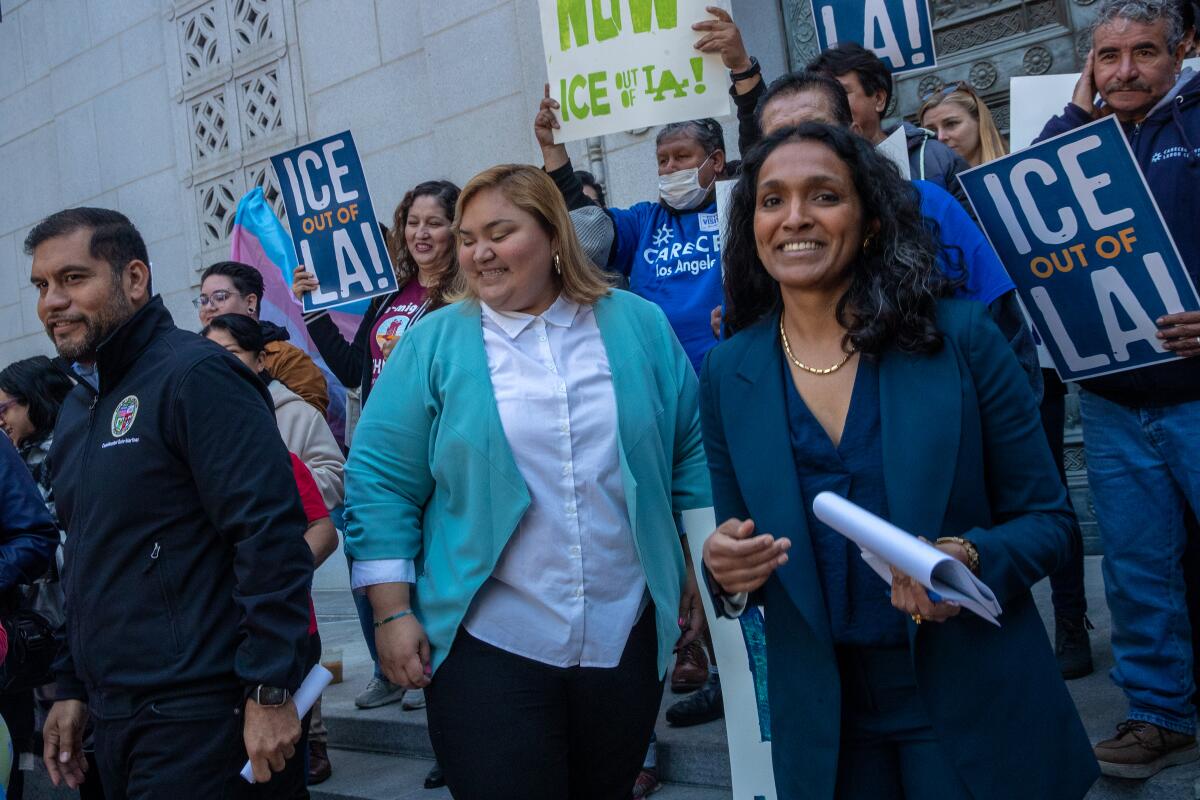L.A. City Council moves ‘sanctuary city’ ordinance forward

- Share via
The Los Angeles City Council on Friday voted to toughen policies around the use of city resources for federal immigration enforcement.
On a 12 to 0 vote, the council asked city attorneys to write a new law that would bar city personnel or resources from being used for immigration enforcement. The law would also bar federal immigration authorities or other entities connected to immigration enforcement from accessing city databases or anyone’s personal data.
City Council members Bob Blumenfield and John Lee were absent from Friday’s vote.
L.A.’s proposal, referred by council members as a “sanctuary city” law, would essentially codify existing policies, including a 2017 executive directive issued by then-Mayor Eric Garcetti.
A proposal by three council members would declare L.A. a ‘sanctuary city’ and bar city personnel or resources from being used in federal immigration enforcement.
If passed, the law would be similar to one in San Francisco. That law prohibits city employees from using city funds or resources to assist U.S. Immigration and Customs Enforcement, or ICE, officers in the enforcement of federal immigration laws unless such assistance is required by federal or state law.
The council on Friday also asked for a report back that details any “current gaps” between LAPD Special Order No. 40, a department policy that prohibits police officers from initiating contact with anyone for the sole purpose of learning their immigration status, and Garcetti’s 2017 directive. The council also asked for a report on instances when city departments have assisted ICE.
Those reports are intended to answer outstanding questions about the city’s existing policies.
The motion voted on Friday by the council says that policies allow ICE officers to access city jails to interrogate people in LAPD custody. The motion also states that LAPD officers are permitted to transfer individuals to ICE custody, even when judicial warrants are not issued.
On Friday, however, the LAPD disputed such claims.
LAPD Capt. Anthony Otero, assistant commanding officer of the department’s Custody Services Division, said the LAPD doesn’t allow ICE to enter LAPD jails to interrogate people. Otero also said that the LAPD doesn’t transfer people into ICE custody without a judicial warrant.
Describing the LAPD’s relationship with ICE, Otero said ICE will “fax us holds on occasion for persons we have in custody, at which point we follow our polices.”
Asked to describe its “policies,” the LAPD didn’t immediately provide The Times an answer.
ICE declined to comment Friday on the “sanctuary city” proposal. The spokesperson said the agency doesn’t comment on pending legislation.
The “sanctuary city” motion was brought forward earlier this year by Councilmembers Nithya Raman, Eunisses Hernandez and Hugo Soto-Martínez. It was seconded by Councilmembers Curren Price and Heather Hutt.
Some of their colleagues asked for more clarity about the city’s policies at a March City Council committee hearing on the motion.
Is there abandoned furniture on your block? Pothole driving you nuts on your commute? Use Shape Your L.A. to learn how to get your city government to address everyday issues.
Councilmember Monica Rodriguez, who represents the northeast San Fernando Valley, said at that meeting she was “confused” by suggestions that local government is cooperating with ICE.
“But more importantly, the suggestion that the city hasn’t already adopted these principles,” she said.
Rodriguez also said at that meeting there had been “unintended consequences” because of the city’s policies around immigration.
She said that when President Biden came into office, the city attempted to participate in the reunification of children who had been separated from their immigrant families, but had to leave that work to Los Angeles County.
“We were unable to participate because of the policies that we had adopted,” Rodriguez said.
Senate Bill 54, California’s so-called sanctuary state law, passed in 2017. In 2019, the L.A. City Council passed a resolution declaring L.A. a “city of sanctuary” but the move had no legal teeth.
After L.A. city attorneys draft the ordinance supported by council members at Friday’s meeting, it will return to the council for a vote.
More to Read
Sign up for Essential California
The most important California stories and recommendations in your inbox every morning.
You may occasionally receive promotional content from the Los Angeles Times.













